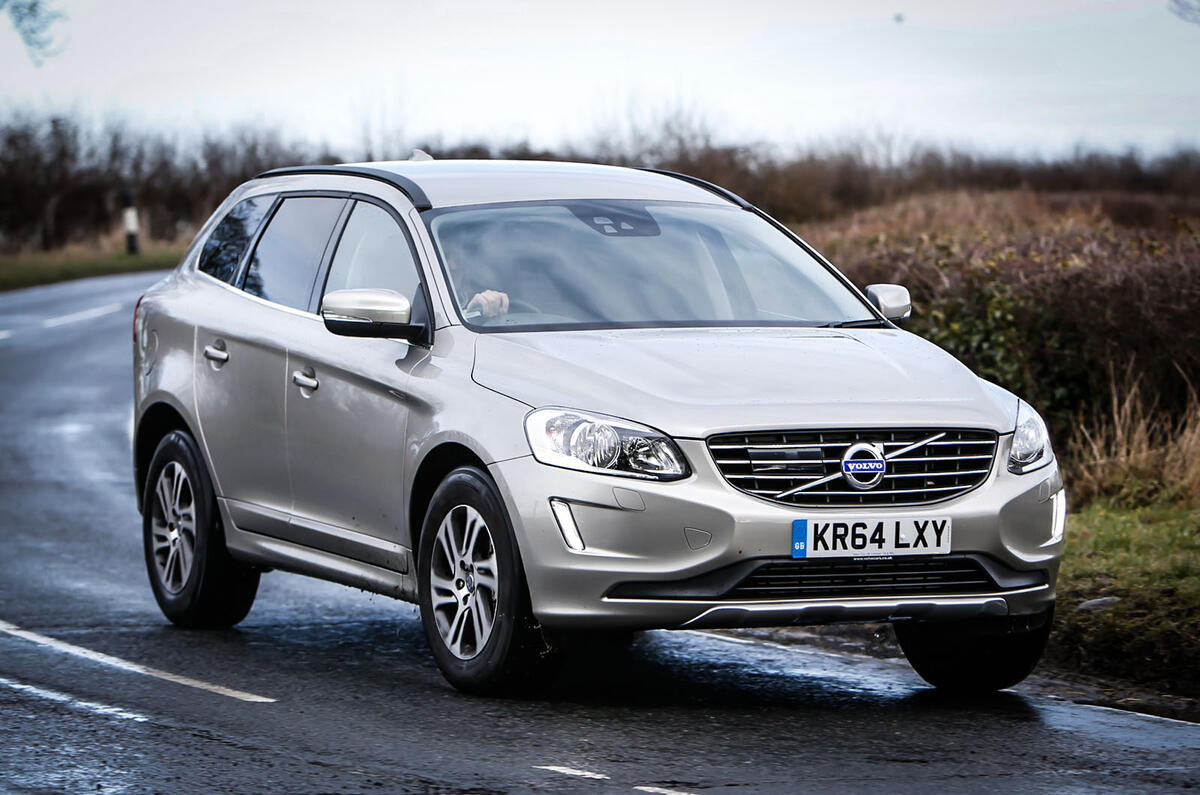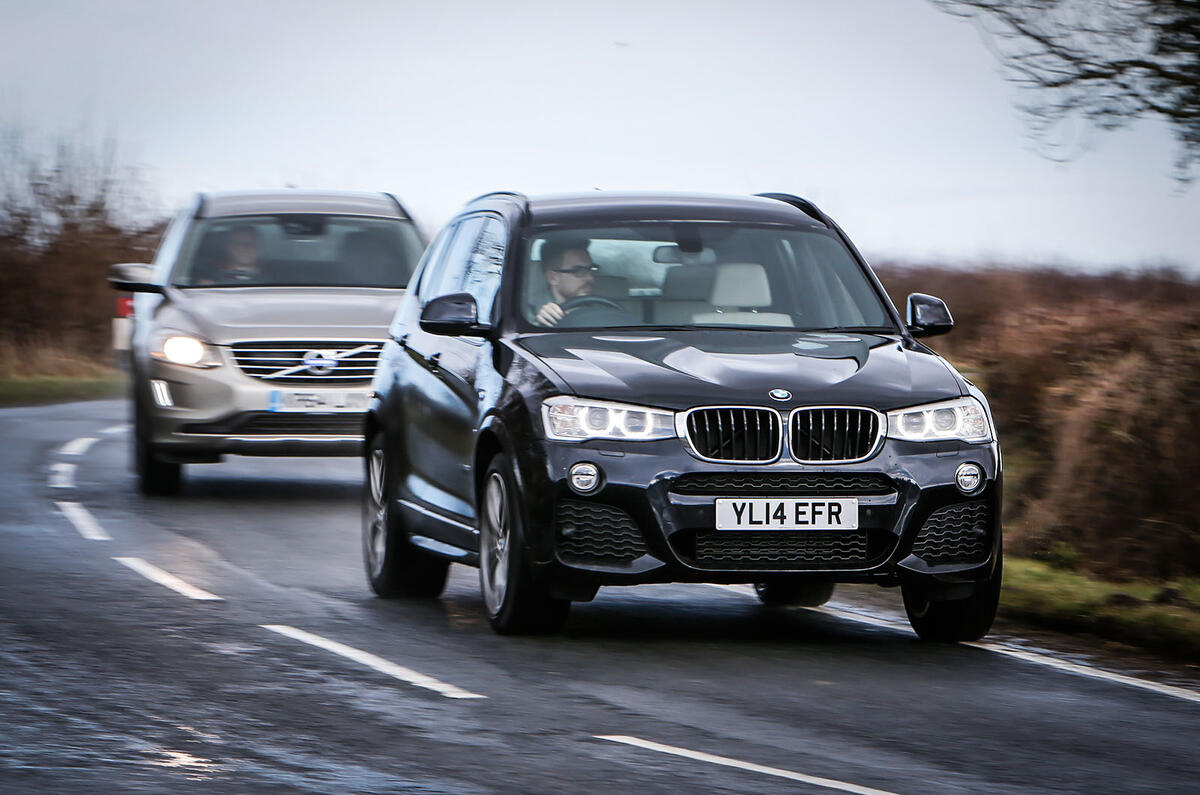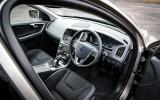Hmmm, I don’t like the Land Rover Discovery Sport. That, at least, is all that occupies my mind for the first 30 minutes behind the wheel.
This is supposed to be a new take on the Freelander, yet I’m confronted with an interior that looks and feels five years old. This pre-dated feel is reinforced with every turn of the four-cylinder diesel engine’s crankshaft, too, its coarse nature betraying the fact that it is actually five years old. And all of this, I idly muse, even though this is the newest and one of the more expensive options in its class.
After all, when you’re attempting to muscle in on a market occupied by the likes of the BMW X3 – frequently regarded as one of the best mid-sized SUVs on sale – then you really need to push the boat out. Your car needs to be competitive in every aspect, if not exceptionally so, and offer several additional facets of reward in order to topple such heady competition.
The Discovery Sport doesn’t face competition just from Germany, however. These days, every manufacturer is in on the SUV game, exploiting what has rapidly developed into an incredibly lucrative sector. So, in order to find out whether the Land Rover really has what it takes to justify a place on your drive, we’re pitching it at a broad spectrum of alternatives.
First to join the Discovery Sport just outside Swindon, prior to a cross-country trek that will put several hundred miles on the odometers of all here, is the Volvo XC60. It packs Volvo’s frugal new D4 engine, which isn’t offered with four-wheel drive yet, and is a quietly appealing car. It’s also one that, in most cases, wouldn’t appear out of place parked nose to nose with the new Land Rover in the high-end residential areas frequently occupied by these cars.
Read the full Land Rover Discovery Sport review
Next into the starting blocks is the Hyundai Santa Fe. Like the Land Rover, it sports a diesel engine, four-wheel drive and seven seats. It may not have the badge or the off-road credentials, but what it majors on is value for money and ease of use.
Lastly, the main threat – the five-seat, four-wheel-drive X3 – rolls in. It’s this that the Land Rover will have to work hardest to overcome, but that’s not to say the other cars here are completely outgunned.
However, it’s immediately apparent that the Land Rover is the one getting the most attention. Although I’m not personally sold on the ‘inflated Evoque’ looks and the somewhat brash ‘Discovery’ badge on the nose, the Land Rover is unquestionably the most interesting to look at.
Some of that interest from passers-by might be lost when you tell them how much it costs, though. This flagship HSE version, in Luxury specification, racks up the register at a wince-inducing £42,995. Compensation comes in the form of an equipment list that’s as long as your arm, including features such as a stout 11-speaker stereo and heated and cooled front seats, but it still feels a hefty price for a four-cylinder diesel SUV.
That said, the others may be cheaper at face value – the Volvo starts at £34,010 in automatic form, the Hyundai £35,430 and the BMW £35,370 – but rampage through the options list and it’s not difficult to come within spitting distance of the Land Rover’s price.
Read the full BMW X3 review
The BMW and Volvo, as tested here, knock on the door of £44k and £40k respectively, leaving the £36k Santa Fe as the best value option in terms of toys per pound. Even if you do go box-ticking bonkers, though, you’ll still struggle to match the Discovery Sport’s vast battery of kit.
Perhaps it’s not entirely without merit, then. There’s still much that the Land Rover needs to do, though, in order to overcome its obvious foibles. So to fully establish what it’s really like, we set out from Membury services and dive off into the countryside south of Swindon.
Here, the Discovery quickly transpires to live up to its ‘Sport’ moniker. The suspension is fairly stiff, the steering hefty and the intent clear. It’s by no means a Porsche Macan, but this is an SUV – despite its size and apparent nature – that rewards the keen driver. Even though the roads are slick with a mixture of sleet, rain and mud, it retains an impressive amount of grip and turns in to corners in a precise, poised fashion.
It’ll understeer predictably when pushed but, other than an initial light tip onto its outside wheel, it corners in a flat fashion. Wind it out across some sweeping country roads and it tackles everything you throw at it with aplomb, feeling eager and enjoyable rather than unsettled.
It’s only the powertrain that takes the edge off the experience. The 2.2-litre diesel puts out 188bhp and 310lb ft, enabling 0-62mph in 8.9sec – not earth-shattering but more than enough for its class. Peak torque is generated from a low 1750rpm, so once the Discovery Sport is rolling, it surges along with aplomb. The engine isn’t particularly quiet, though, and its vibrations occasionally intrude into the cabin.
The nine-speed automatic gearbox could be better as well. From a standing start, it’ll hesitate to transmit drive, making it difficult to execute a prompt getaway. Additional throttle application results in nothing more than an even more vigorous take-off when it actually responds.
You soon learn to drive around it, but it’s still a disappointment. The consolation is that gearshifts are otherwise prompt and quick, even when commanded manually via the paddles, and the engine pulls heartily enough through its rev range. Braking power is excellent, too, and easily judged.
Read the full Hyundai Santa Fe review
Once up to cruising speed, the Discovery Sport’s firm ride doesn’t translate into discomfort. It lopes along with ease, in a settled fashion, and the quiet cabin makes longer trips easy to endure. There’s a vast amount of space, too.
The quality of the cabin is acceptable, but there are some easily marked plastics in places. It’s functional and logical, rather than elegant and inspirational. There are issues, though, such as a panoramic roof that doesn’t extend forward far enough to make much difference to front-seat occupants.
Unlike the terrain-following Land Rover, the BMW has much more compliant suspension that allows for a moderate amount of body movement. It feels softer, which, in conjunction with lighter steering, delivers a more cosseting feel. Our car was fitted with £650 worth of variable damper control, which allows for stiffer suspension when desired but still not to the extent of that found in the Discovery Sport.
Regardless, many may find the X3 easier to get along with because of its less sharp nature. This is evident in some of the specifications alone; the BMW’s steering is 3.0 turns from lock to lock, whereas the Land Rover’s is a more hyperactive 2.4. In Sport mode, the X3 will tighten up and corner faster than the Discovery Sport, but not in quite such a rewarding fashion.
The BMW may not be as exciting to drive as the Land Rover, but it does feature a much more competent powertrain. Its 2.0-litre diesel puts out 188bhp and 295lb ft, and although on paper that doesn’t match the Land Rover on torque, it feels more eager at lower revs.
This snappy response is bolstered further by the eight-speed automatic ’box, which rifles through its ratios in a suitably prompt fashion. It doesn’t downshift as unnecessarily often as the Land Rover, but it does intermittently hang on to the gears for a little too long at lower speeds and labour the engine. The BMW’s diesel isn’t a particularly refined one, either, but it is a little less boomy than the Discovery Sport’s powerplant.
Inside the BMW, there’s masses of space, too, although it’s purely a five-seater. The interior isn’t as cohesive as the Land Rover’s – it looks like a scaled-up 3 Series and doesn’t quite fit the car correctly – but the quality of the materials is generally very good. Its switchgear, particularly, feels delightfully well damped and securely fixed.
Read the full Volvo XC60 review
The XC60 outdoes both on the comfort and refinement front. It also has the most aurally gratifying diesel of the lot. The 178bhp, 295lb ft 2.0-litre motor delivers prompt, lively-feeling performance, too, unburdened by the frictional and weight penalties incurred by a four-wheel drive system.
However, the Volvo falls down in two places. Firstly, although the cabin is easily the most visually appealing of the cars here and front space is excellent, the rear is quite cramped. Secondly, there’s not much to reward the driver.
Although it damps out the bumps well and tolerates the curves adequately enough, there’s little in the way of feedback – and the harder you push, the more notably the flaws in its chassis become apparent. Unsettlingly, there’s sometimes pronounced steering kickback in long, sweeping high-speed turns.
Its lack of four-wheel drive, in this specification at least, stunts its overall rating slightly, too. Accelerate with anything resembling vigour out of a vaguely damp junction and it’ll easily overpower the front wheels. You’ll also notice some torque-induced pull if you’re driving at speed through corners as well. That said, the eight-speed Geartronic automatic works well, although shifts aren’t executed as quickly as in the BMW or Land Rover.
So what of the Santa Fe, the last in the line? Well, truth be told, it does a very competent job. It rides in a pliant, supple fashion and exhibits no unpleasant tendencies when pushed. The steering is devoid of feedback, admittedly, but its light weight makes manoeuvring easy.
The Hyundai is the slowest car here, on paper, but it doesn’t feel like it gives up much to the others in the real world – in part, thanks to a substantial 322lb ft at low revs from its 2.2-litre diesel. Its 194bhp diesel is a pleasantly quiet affair, too, and ideal for simply cruising around. Similarly, the six-speed automatic transmission operates in an unobtrusive fashion and, unlike the Discovery Sport, the Santa Fe will happily trundle away from junctions without hesitation.
Its interior isn’t exciting or as well finished as the others here, but it feels durable. It’s a shame the seats lack lower back support, though, because they can become tiring to sit in on longer trips. Outside of that, then, the Hyundai majors on everyday usability. It’s spacious, well equipped and immensely easy to drive. But although it has its strong points, it’s the most amorphous car within this group and it doesn’t leave much of a lasting impression.
It’s worth making a note that the Discovery Sport is not a particularly efficient mode of transport, averaging 33mpg during our test against a claimed 44.8mpg. Its rivals, which are claimed to average between 52.3 and 60.1mpg, returned closer to 40mpg without effort.
The verdict
We pitch back onto the motorway, heading towards the centre of Weston-super-Mare before hitting its fine beaches to conclude our test. It’s at this point that, despite my initial reservations and after having spent some four hours behind the wheel of the Discovery Sport, I realise I’m enjoying driving it.
Compared with the other cars here, it’s more exciting, interesting and desirable, and by such an extent that its imperfections eventually pale into comparative insignificance. Furthermore, it’s the Land Rover that feels like it could conquer a mountain, and that’s what many look for in an SUV, regardless of whether they’ll ever venture off the beaten path.
The BMW is unquestionably an impressive piece of machinery, but it lacks the Discovery Sport’s on-road verve and practical edge, landing it in second place. It does offer a more relaxed, rounded performance, but the Land Rover transpires to be the kind of car that you step out of and, with a glance backwards, quietly wish you could continue driving onwards in. For a four-cylinder diesel SUV, that’s an impressive feat.
In third place is the Volvo. It has its charms, such as its quiet cabin, but its chassis leaves it trailing in the wake of the Discovery Sport and X3. Similarly, the Santa Fe is not devoid of appeal, but it lacks the desirability and luxury feel necessary to come out on top here. Consequently, it finishes last, but even to be in competition with such strong rivals shows how commendable a car it is.
Unless you absolutely, positively must have the newest car on the block, however, you’d be advised against buying a Discovery Sport now, because the new, modern Ingenium engines are due soon. Their fitment will hopefully combat the Land Rover’s lack of mechanical refinement, unimpressive fuel economy and occasionally sluggish responses. Onwards and, aptly for a Land Rover, upwards.
Read Autocar's previous comparison - Fast estates on test
Land Rover Discovery Sport HSE Luxury
Price £42,995; Engine 4 cyls in line, 2179cc, turbodiesel; Power 188bhp at 3500rpm; Torque 310lb ft at 1750rpm; Gearbox 9-spd automatic; Kerb weight 1863kg; Top speed 117mph; 0-62mph 8.9sec; Economy 44.8mpg; CO2 rating 166g/km
BMW X3 xDrive20d M Sport
Price £35,370; Engine 4 cyls in line, 1995cc, turbodiesel; Power 188bhp at 4000rpm; Torque 295lb ft at 1750-2500rpm; Gearbox 8-spd automatic; Kerb weight 1820kg; Top speed 131mph; 0-62mph 8.1sec; Economy 54.3mpg; CO2 rating 138g/km
Volvo XC60 D4 Geatronic SE Nav
Price £34,010; Engine 4 cyls in line, 1969cc, turbodiesel; Power 178bhp at 4250rpm; Torque 295lb ft at 1750-2500rpm; Gearbox 8-spd automatic; Kerb weight 1935kg; Top speed 130mph; 0-62mph 8.5sec; Economy 60.1mpg; CO2 rating 124g/km
Hyundai Santa Fe 2.2 CRDi Premium SE 4WD 7-seat auto
Price £35,430; Engine 4 cyls in line, 2199cc, turbodiesel; Power 194bhp at 3800rpm; Torque 322lb ft at 1800-2500rpm; Gearbox 6-spd automatic; Kerb weight 2001kg; Top speed 118mph; 0-62mph 10.1sec; Economy 41.5mpg; CO2 rating 178g/km
Get the latest car news, reviews and galleries from Autocar direct to your inbox every week. Enter your email address below:























































Join the debate
Add your comment
Really interesting
Great stuff Autocar, it really brings these reviews to life.
Keep it up guys.
Interesting review too, I don't really agree with the outcome from a personal point of view (and for what I'd want out of one of these cars), but in terms of real world sales figures, it's probably spot on.
Hi Lewis, first, very good of
Regarding the test results, I appreciate you will always get people questioning/moaning about results. It comes with the territory I guess. But in this case, going strictly by the points made in the article itself, the points in favour of the BMW do seem to stack up quite a bit more than the Discovery Sport, as I pointed out in my original comment.
So, it was a bit of a surprise to read that the latter pulled out the win. And that's why, rightly or wrongly, the impression of subjective preference is created. But hey, that's just my personal opinion, which I accept is just as fallible as anyone else's.
Comments deleted?
I, and I believe one or two other posters, posted comments here that Autocar's own findings in this test didn't really make the case for concluding the Discovery Sport winning, particularly over the X3, at least objectively and that this is indicative of the magazine often giving JLR cars favourable write ups.
But the comments have suddenly disappeared! Surely this can't be because this fine and long standing publication is intolerant of different and sometime opposing viewpoints, can it?
RE: Comments
Hello Overdrive. I'm not aware of any comments being deleted (I've not removed any, at least, as it usually takes a load of other interesting replies with it). You may well find that they've been bumped onto the second or third page though; responses push following messages down one.
If you get the opportunity to drive a Discovery Sport, if you haven't already, do let us know what you make of it. Always interested to hear what the readers think.
I do recall a time when we ran a group test and received precisely one letter apiece for each car involved claiming that, in fact, it should have been the true victor. Swings and roundabouts. Rest assured that there is no favouritism here. I wouldn't want to waste your time.